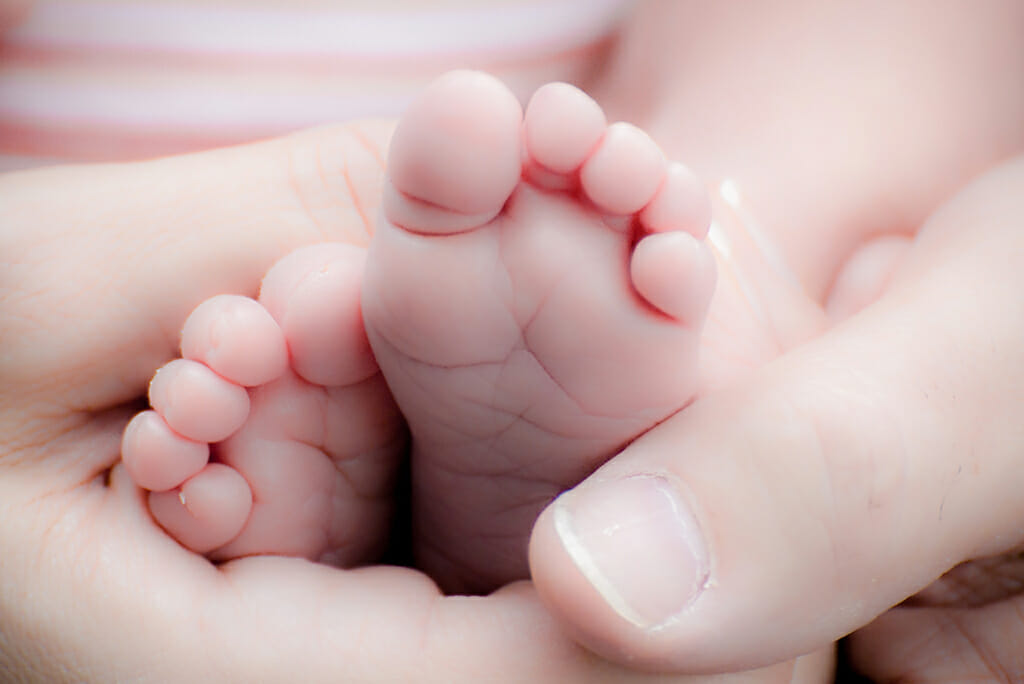
Historic medical developments have led to a current practice, where many babies are kept skin-to-skin in the first hours and perhaps days after birth.
Those parents who endorse the concept of babywearing will then normally proceed to a practice of dressing the baby (and themselves) and then carry the baby in a baby-carrying device, such as a sling, wrap, soft structured carrier, etc.
But could it be that we are missing something by creating that barrier of clothing between our baby and us as caregivers in the first few months after birth?
Skin-to-skin contact vs. clothed contact, right after birth
A unique Russian/Swedish research collaboration has provided some insights into this specific question. In their research design, they divided newborns into different groups. One group received skin-to-skin contact with their mother after birth. Another group also received contact, but with the vital difference that these children were dressed, hence barring direct skin-to-skin contact. A third group was separated after birth and then re-introduced to the mother after several hours.
The researchers conducted several measurements. One of the measurements targeted the newborns’ ability to maintain a stable temperature in different body sites. Temperature is here considered an index of stress-related effects on the baby’s blood circulation, so a lower temperature of the extremities, such as the feet, would reflect a higher level of stress in the baby. When comparing the temperature of the feet with 15-minute intervals across the three groups for 120 minutes after birth, the temperature was the highest for the skin-to-skin contact group, lower for the “dressed-contact” group, and even lower for the separated group.1
So how can we interpret these results? It seems, first of all, that newborns that receive contact with their mother have a lower stress level than newborns that are separated. But we can also see a clear difference in physiological response (the temperature) to contact, when there is a clothing barrier. In this case, clothes made the mother-newborn contact less effective in regulating the foot temperature of the newborn.
But the story does not end here: The researchers went on to conduct measurements of the children’s capacity for self-regulation when they were 12 months old. In this study, self-regulation has to do with the child’s display of positive or negative emotions and behaviors during social interactions. And here an almost exact mirroring of the temperature results was found. The postnatal skin-to-skin contact children performed significantly better than the children who were separated from their mothers after birth, with the “dressed contact” children falling in the middle of these results.2
What is the tentative conclusion of this research? It seems that for newborns, clothing does interfere negatively in creating the most optimum physiological regulation, when compared with skin-to-skin contact. Being in “dressed contact” is, however, still significantly better than being separated.

Skin-to-skin contact beyond the immediate postpartum period
Do we know anything about what happens when babies are kept skin-to-skin beyond the immediate postpartum period? A Canadian study asked a group of middle-class mothers to engage in daily skin-to-skin contact for the first month after birth. For comparison, they included another group of middle-class mothers, where they intentionally did not suggest to them to engage in skin-to-skin contact.
By setting up the research in this fashion, they were able to learn several things. First, are Canadian middle-class mothers willing and able to engage in daily skin-to-skin contact when prompted and assisted by medical staff? And how much skin-to-skin contact do normal Canadian middle-class mothers actually engage in, when no one suggests this practice to them – this group could be considered to represent the “cultural norm” for the amount of skin-to-skin contact amongst Canadian middle-class mothers.
The research demonstrated that, when urged to do it by medical staff, Canadian middle-class mothers are indeed willing and able to engage in daily skin-to-skin contact, with some 5-6 hours per day in the first week after birth, and 2-3 hours per day in week 2-4.
It also showed that the Canadian middle-class cultural norm (by looking at the comparison group) for skin-to-skin contact in the first month after birth is to not really do it – i.e. less than 30 minutes per day.
So, very briefly, how did this “unusual” or “un-cultural” approach of engaging in daily skin-to-skin contact in the first month after birth affect the mothers’ and their babies’ development, when compared with the normal approach of very little daily skin-to-skin contact?
Mothers engaging in daily skin-to-skin contact were found to be better able to maintain breastfeeding and also suffered from less depressive symptoms.3 4 They also appeared less stressed, with a sharper reduction in the stress hormone cortisol over the first month.4
The babies showed a very strong acceleration of their socio-emotional development – at three months, their behavior in a well-established psychological test (The Still Face Test) resembled what you would normally expect in babies at 6-7 months of age.5 This behavior at such a young age is also predictive of a later secure attachment. So all in all, the research demonstrated specific effects of daily skin-to-skin contact that are very much in demand in the whole perinatal medical and infant mental health community.
In the ideal world, the research group would also have included a “babywearing control group”, so any differences in outcomes for babies carried skin-to-skin, compared to babies carried in dressed condition could have been tested.
To my knowledge, this is the extent of the current research available for us to make decisions on how to care for our babies in the first few months after birth, both as parents and as perinatal medical professions, as regards the specific question of skin-to-skin contact versus “dressed contact”.
Recommendations to parents
Based on the experiences obtained through the Canadian study, Prof. Bigelow, who initiated and led the study, recommends parents to engage in daily skin-to-skin contact, ideally for several hours a day in the time following birth. If parents employ a baby carrier, which accommodates skin-to-skin contact, they will be able to have their hands free, and, as needed, carry out domestic or work related tasks, while taking fundamentally good care of their baby.
As to the length of the period of engaging in skin-to-skin contact, Prof. Bigelow found that, on average, the babies in the study signaled to their parents that about a month of daily skin-to-skin contact was sufficient for them. As with all parenting advices, we suggest you follow your specific baby’s signals and needs and carry on as long your baby seems comfortable with it.
About Dr Henrik
Dr. Henrik Norholt is a member of The World Association of Infant Mental Health, The Marcé Society for Perinatal Mental Health and The Society of Emotion and Attachment Studies. He is an expert in the effects of baby carrying on child psychological and motor development having studied it for the past 15 years. He is a frequent lecturer and thesis supervisor at numerous universities, colleges, association meetings and international conferences.
References :
1. Bystrova K, Widström AM, Matthiesen AS, et al. Skin-to-skin contact may reduce negative consequences of “the stress of being born”: a study on temperature in newborn infants, subjected to different ward routines in St. Petersburg. Acta Paediatr Oslo Nor 1992. 2003;92(3):320-326.
2. Bystrova K, Ivanova V, Edhborg M, et al. Early contact versus separation: effects on mother-infant interaction one year later. Birth Berkeley Calif. 2009;36(2):97-109. doi:10.1111/j.1523-536X.2009.00307.x
3. Bigelow AE, Power M, Gillis DE, Maclellan-Peters J, Alex M, McDonald C. Breastfeeding, skin-to-skin contact, and mother-infant interactions over infants’ first three months. Infant Ment Health J. 2014;35(1):51-62. doi:10.1002/imhj.21424
4. Bigelow A, Power M, MacLellan-Peters J, Alex M, McDonald C. Effect of mother/infant skin-to-skin contact on postpartum depressive symptoms and maternal physiological stress. J Obstet Gynecol Neonatal Nurs JOGNN NAACOG. 2012;41(3):369-382. doi:10.1111/j.1552-6909.2012.01350.x
5. Bigelow AE, Power M. The effect of mother-infant skin-to-skin contact on infants’ response to the Still Face Task from newborn to three months of age. Infant Behav Dev. 2012;35(2):240-251. doi:10.1016/j.infbeh.2011.12.008




